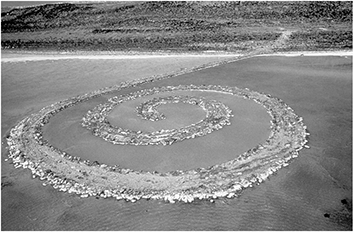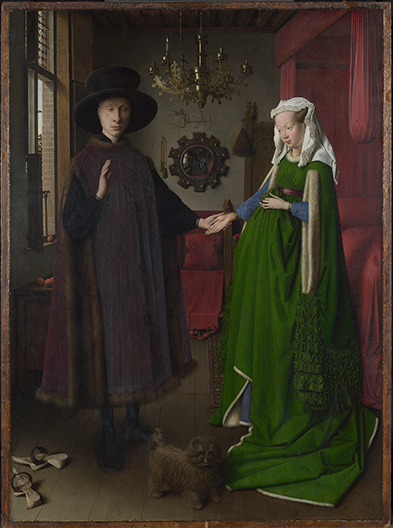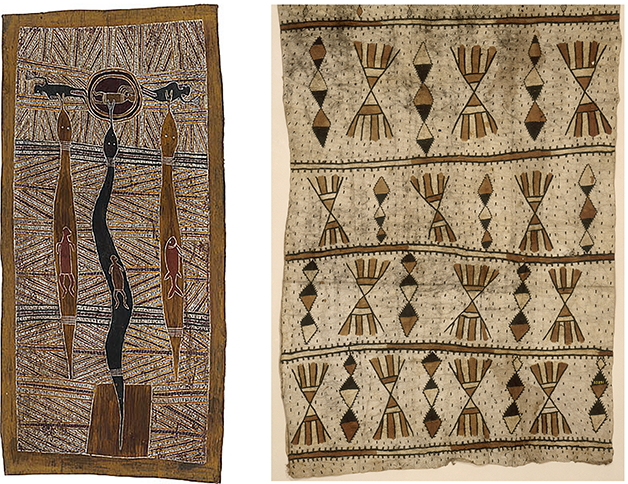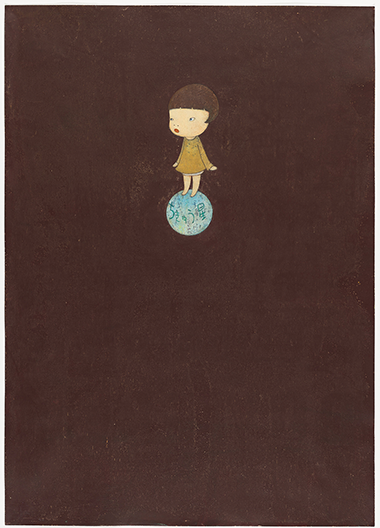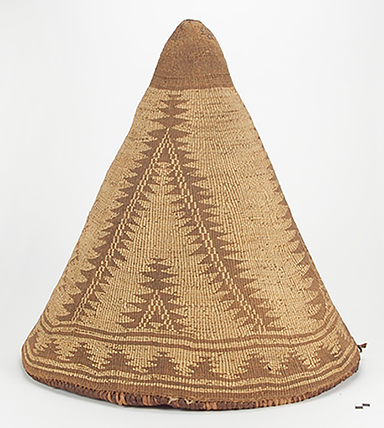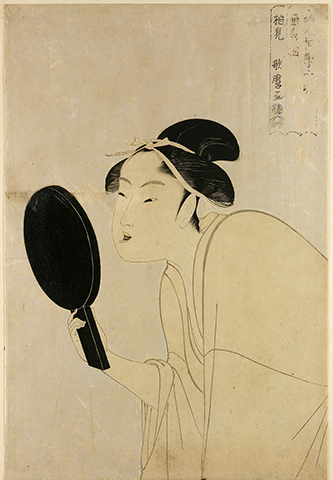Test Guide
Section 7: CSET: Art Subtest II
Sample Multiple-Choice Questions
Expand All Answers | Collapse All Answers
Responding
3.1 Perceive and Analyze Works of Art
1. Use the reproduction below of Spiral Jetty (1969–1970) by Robert Smithson to answer the question that follows.
Rocks, mud, and salt crystals form a spiral-shaped earthwork that juts out from the shore and into the Great Salt Lake in Utah. Looked at from the lake, the spiral jetty curves inward to the right. The spiral ends rather than connect with its nearest part. The jetty can be seen because it is above the level of the water.
In terms of the interaction between elements of art and principles of design, this work best illustrates the way in which:
- shape evokes subordination.
- value evokes contrast.
- line evokes movement.
- texture evokes emphasis.
- Enter to expand or collapse answer.Answer expanded
- Correct Response: C. The earthwork is a jetty made in a spiral fashion. The viewer’s eye tends to trace the circular line of the work to the end of the spiral, lending the work a strong sense of visual movement.
3.1 Perceive and Analyze Works of Art
2. Use the reproduction below of a painting by Jan van Eyck to answer the question that follows.
The work is a double portrait of a man and a woman standing in their bedroom. It is a full-length portrait. The man wears a long dark cloak and a wide-brimmed black hat. The man is holding the woman’s right hand with his left hand. Hi right hand is slightly raised, perhaps as if committing an oath. The woman’s left hand appears to be gathering up large bunches of fabric in the midsection of the dress. A small brown dog stands at their feet, looking directly at the viewer. A pair of wooden clogs are on the floor near the man and a pair of red slippers is behind them, suggesting that the couple are not wearing footwear. Behind the woman on one side of the room is a bed, textured in lush red fabric. Behind the man is the opposite wall. A window there allows light into the scene. On the sill and a small table beneath the window are four oranges. Behind the couple hanging from the ceiling is an elegant, gold-colored chandelier. Only one of the candles is burning. On the far back wall is a small convex mirror that shows the scene from behind, in miniature. Directly above the mirror are the words “Jan van Eyck was here in 1434.”
To understand the way in which this work documents a specific event, it would be especially important for a viewer to understand that:
- virtually every object in the painting has a specific symbolic meaning.
- van Eyck's style tended to be more static than that of many of his contemporaries.
- paired portraiture was a long-established tradition in Flemish art.
- oil painting was considered a radical new technique at the time this work was created.
- Enter to expand or collapse answer.Answer expanded
- Correct Response: A. Jan van Eyck's "The Arnolfini Wedding Portrait" is rich in symbolism. Many aspects of the work symbolize wealth in fifteenth-century Belgium, such as the subjects’ clothes, the fabrics used in the interior scene, and the oranges, which would have been very expensive to purchase at the time. The dog most likely symbolizes fidelity. The lone burning candle in the chandelier might represent a holy presence or, in one interpretation, it represents life.
3.1 Perceive and Analyze Works of Art
3. A number of twentieth-century artists used unconventional or controversial media in their work (e.g., Duchamp's readymades, the minimalists' use of industrial materials and techniques, performance art's use of the body itself). Each of these innovations prompted some viewers to refuse to define them as legitimate art forms. Which of the following is a valid rationale for works, such as these, that defy conventional expectations?
- The value of such art lies not in its shock value as such, but in how it challenges viewers to see in new ways.
- In order to make interesting work, one must necessarily shock the sensibilities of the art world.
- While appropriating new media can be shocking initially, such artistic innovation is usually quickly assimilated.
- That some see this work as shocking is irrelevant to the art and is only a mark of some viewers' limitations.
- Enter to expand or collapse answer.Answer expanded
- Correct Response: A. Definitions of art have always varied and probably always will. One characteristic of art throughout the millennia, though, is its innovative qualities. Artists have always sought new ways of expression. Works that defy conventional expectations, such as in the Dada movement, encourage viewers to experience artistic expression in new ways and, in a wider sense, to see things in new ways.
3.1 Perceive and Analyze Works of Art
4. Creating a sense of playfulness in the design of buildings was the focus of primarily which of the following architectural movements?
- postmodern
- neoclassical
- art deco
- baroque
- Enter to expand or collapse answer.Answer expanded
- Correct Response: A. Postmodern architecture was a style of architecture that began in the 1970s as a reaction to the austere minimalist designs of modernist architecture. It is characterized by a blending of classical architectural features with use of modern materials, an interest in color, and a playful sense of whimsy.
3.2 Interpret Intent and Meaning in Works of Art
5. Use the reproductions below of a bark painting of The Wawalag Sisters and the Rainbow Serpent (1959) by Mawalan Marika [left] and a Polynesian textile (nineteenth century) by an unknown artist [right] to answer the question that follows.
The work on the left, The Wawalag Sisters and the Rainbow Serpent, is a vertically oriented bark painting that features three serpent-like shapes. On each of the three serpent shapes are smaller, different figures, including a fish and what appear to be two people. Above the heads of the three serpents are three more figures that appear to be lying down. Most of the hues are shades of brown. The central serpent is black. The background of the work consists of rectangular shapes and diagonal lines.
The work on the right, a Polynesian textile, is a vertically oriented work that consists of repeated geometric shapes, many of them triangular. Most of the hues are shades of brown. The shapes are in four lateral sections separated by two small parallel lines each. Small dots appear throughout the background of the work.
Which of the following statements offers the best comparison of how elements of art are used in these two works?
- The way line is used in the bark painting imparts a textural quality absent from the textile.
- The way value is used in the textile imparts a sense of dramatic contrast that is not evident in the bark painting.
- The way shape is used in the bark painting imparts a narrative dimension absent from the textile.
- The way line is used in the textile imparts an energetic quality that is lacking in the more static bark painting.
- Enter to expand or collapse answer.Answer expanded
- Correct Response: C. The principal shapes in the composition on the left are three serpent-like shapes referred to in the title of the work. On each of the three serpent shapes are smaller, different figures, including a fish and what appear to be two people. Above the heads of the three serpents are three more figures. The implied visual movement of the serpents and the appearance of relationships among them and the other figures suggest that a story is being told in the work. The composition on the right consists of repeated geometric shapes that may have symbolic or abstract meaning but lack the narrative element of the work on the left.
3.2 Interpret Intent and Meaning in Works of Art
6. Use the reproduction below of Tiananmen Square, June 6, 1989 by Jeff Widener to answer the question that follows.
The photograph shows a person holding a bag standing directly in front of a line of four military tanks on a wide street. In the foreground is the top of a city streetlight. The person wears a white shirt and dark pants. The tanks are shades of military green and tan. Their guns are raised. The size of the person is small in comparison to the large tanks. Except for a small visible portion of a vehicle at the top of the composition, the street is empty except for the line of tanks and person standing in front of it.
This work best demonstrates the power of the visual image to:
- portray a relatively insignificant event in a way that makes it appear to have momentous implications.
- create a nonexistent "reality" that is nevertheless utterly convincing to countless viewers.
- make an ambiguous situation appear to have only one valid interpretation.
- crystallize the force and meaning of an event for an audience of millions of people.
- Enter to expand or collapse answer.Answer expanded
- Correct Response: D. The photograph depicts a lone person holding a bag standing directly in front of a line of four military tanks on a wide street in Tiananmen Square, Beijing, in 1989, where a violent government crackdown of student-led protests was underway. The photograph and video of the person standing in front of the tanks were seen worldwide. The person in the photo who came to be known as "Tank Man" and the photo itself became a powerful symbol of defiance.
3.2 Interpret Intent and Meaning in Works of Art
7. Use the reproduction below of a Nepalese work to answer the question that follows.
The painting depicts a large circle and numerous circles within it. The background color is blue. Mixed within the large outer most circle that frames the work and the inner smaller circles, are more circles that overlap with each other, giving the work a rough implied texture. Near the center of the circular design is a thicker white circle than the others that are depicted. Just outside of that circle are nine small geometric shapes colored yellow, orange, and green, matching the colors of the many overlapping thin circles within the overall circle design.
Which of the following types of balance contributes to the portrayal of unity and wholeness in this work?
- crystallographic
- symmetrical
- radial
- asymmetrical
- Enter to expand or collapse answer.Answer expanded
- Correct Response: C. Works of art can be balanced in several different ways or be purposefully unbalanced. This work depicts a circular design. Radial balance refers to works that are circular with elements that spread out evenly from a central point.
3.3 Apply Criteria to Evaluate Works of Art
8. Which of the following questions is most likely to be asked when evaluating an artwork using the aesthetic theory of instrumentalism?
- How can this work influence specific changes within society?
- How do the elements of art in the work elicit a response in viewers?
- How is the artist communicating their emotions in this work?
- How realistic and lifelike do the subjects in the work appear?
- Enter to expand or collapse answer.Answer expanded
- Correct Response: A. Instrumentalism is an aesthetic theory centered on the idea that art serves a specific purpose, often with the intent to persuade viewers regarding social and political issues.
3.3 Apply Criteria to Evaluate Works of Art
9. Use the reproduction below of Patch of the Earth (2001) by Yoshitomo Nara to answer the question that follows.
The painting is vertically oriented. Most of it is a flat dark brown background. Two small figures are in the top center of the composition—a girl wearing a light brown dress who looks toward the left of the composition and an orb that she stands on, which looks somewhat like planet earth.
Which of the following excerpts from an analysis of this work exemplifies the description stage of art criticism?
- It is a subtle work with expressive power of a girl standing on earth. There is a suggestion of the infinite and perhaps a comment about humanity, but the work is wonderfully open to many interpretations.
- The small amount of space taken up by the girl suggests that humans are a small part of the cosmos. Yet she is larger than and stands on planet Earth, which seemingly has the opposite meaning.
- A girl stands on the Earth and looks afar. The dark brown backdrop could be outer space, which lends an air of the unknown that is set at ease by the strong symmetrical balance of the work.
- Most of the composition is background that is colored dark brown. Standing on top of a circle that appears to represent Earth is a girl in a light brown dress, who looks toward the left of the composition.
- Enter to expand or collapse answer.Answer expanded
- Correct Response: D. Description is the first stage of art criticism. It is a simple accounting of what the eye can see in the artwork and does not include analysis, interpretation, or evaluation. In this work, a description would note the background, the figures, the colors—an accounting of the elements of art and principles of design but not what purpose they are being used for or expression they are conveying.
Connecting
4.1 Synthesize and Relate Knowledge and Personal Experiences to Make Art
10. The art of ancient Minoa indicates that ancient Minoans were a culture with primarily which of the following values or interests?
- celebrating the sea
- glorifying the monarchy
- displaying military might
- preparing for the afterlife
- Enter to expand or collapse answer.Answer expanded
- Correct Response: A. The art of ancient Minoa includes many forms, materials, and subjects, but one characteristic of Minoan art is its many depictions of the sea. Ancient Minoa was a seafaring culture, which can be seen in pottery and frescoes that depict dolphins, octopi, and other sea life.
4.1 Synthesize and Relate Knowledge and Personal Experiences to Make Art
11. When sketching an unfamiliar subject, an artist would use gesture drawing primarily for which of the following purposes?
- recording the size of the subject
- choosing which colors to use to depict the subject
- creating details of the subject
- capturing the basic proportions of the subject
- Enter to expand or collapse answer.Answer expanded
- Correct Response: D. Gesture drawings are quick, simple sketches of a subject. They are not intended to capture details or be finished drawings and instead focus on the basic proportions of the subject matter.
4.1 Synthesize and Relate Knowledge and Personal Experiences to Make Art
12. Which of the following scenarios is most likely to result in a successful public arts project?
- choosing a site that affords the most possible artmaking options for the project
- having community involvement from the onset of the project
- creating a team to monitor project progress and recommend changes if needed
- defining for the artist or artists the desired aesthetic outcome of the project
- Enter to expand or collapse answer.Answer expanded
- Correct Response: B. Public art refers to art in public spaces that is temporary or permanent. It can take a variety of different forms, such as murals, sculpture, and performance art. Since it is often created expressly for the communities in which it will be displayed, public art instills meaning for communities and is most successful when the community is involved from the start.
4.2 Relate Artistic Ideas and Works with Societal, Cultural, Historical, and Professional Context to Deepen Understanding
13. Use the image below of an object from the Wintun culture (c. 1890) to answer the question that follows.
Traditionally, objects such as this were created primarily to serve as:
- containers for carrying food or other loads of various kinds.
- vessels for use in religious practices.
- commodities for trade with geographic neighbors.
- a means of exploring sculptural form.
- Enter to expand or collapse answer.Answer expanded
- Correct Response: A. The Wintu are Native Americans who originally lived in what is now Northern California. Conical burden baskets such as this were used to carry a variety of things, including berries and acrons.
4.2 Relate Artistic Ideas and Works with Societal, Cultural, Historical, and Professional Context to Deepen Understanding
14. Use the reproduction below of a Japanese ukiyo-e woodblock print (c. 1800) to answer the question that follows.
The woodblock print is vertically oriented. It features a woman holding and looking at a round object that is probably a mirror. Most of her shape is due to contour lines and there is little in the way of shading or depth used in her depiction. Perspective is such that her torso merges from the right side of the composition and the rest of her body is off screen. Small Japanese characters are in the top right of the composition. Her garment is flowing and light tan in color, as is the color of most of the composition except for the black mirror.
The cropped formats, flattened forms, and subjects drawn from the theatre and everyday life in prints such as this inspired the paintings and prints of:
- cubists.
- impressionists.
- neoclassicists.
- Pre-Raphaelites.
- Enter to expand or collapse answer.Answer expanded
- Correct Response: B. Many characteristics of Japanese ukiyo-e woodblock prints—everyday subjects, the viewer’s perspective coming from a slight angle, flat planes of color, and bold lines—influenced European Impressionists, such as Mary Cassatt and Edgar Degas, in the late nineteenth century.
4.2 Relate Artistic Ideas and Works with Societal, Cultural, Historical, and Professional Context to Deepen Understanding
15. Compared to traditional Chinese calligraphy, traditional Islamic calligraphy is more of an expression of:
- poetic musing.
- religious belief.
- aesthetic pleasure.
- political thought.
- Enter to expand or collapse answer.Answer expanded
- Correct Response: B. Traditional Islamic calligraphy was strongly tied to the Quran, the principal religious text of Islam. While traditional Chinese calligraphy often had a spiritual intent, it was not as specifically tied to religious text as traditional Islamic calligraphy.
Acknowledgments
Question Number 1. From: Art © Estate of Robert Smithson/Licensed by VAGA, New York, NY. Reprinted with permission.
Question Number 2. From: van Eyck, J. The Arnolfini Wedding Portrait (1434). National Gallery, London. As appears in L. S. Adams, (1999), Art Across Time: The Thirteenth Century to the Present (Vol. II) (p. 538). Boston: McGraw-Hill College. Reprinted with permission.
Question Number 5. From:
- Mawalan Marika, The Wawalag Sister and Rainbow Serpent. © 2006 Artists Rights Society (ARS), New York/VISCOPY, Australia. Reproduction, including downloading of Marika works is prohibited by copyright laws and international conventions without the express written permission of Artists Rights Society (ARS), New York. Reprinted with permission.
- Tapa (textile). From the Cook Islands, Polynesia, 19th CE. Beaten and painted bark, tapa, 91 x 134 cm. SG.53.291. Photo: Daniel Arnaudet. Location: Musee du Quai Branly, Paris, France. Photo Credit: © RMN-Grand Palais / Art Resource, NY.
Question Number 6. From: AP Images/Jeff Wilder. Reprinted with permission.
Question Number 7. From: Nepalese School / Nepalese. Om cosmo Mandala, depicting the wholeness, unity and renewal (gouache on cloth). Photo © Stefano Baldini / Bridgeman Images.
Question Number 9. From: Nara, Yoshitomo (b. 1959) © Yoshitomo Nara. Patch of the Earth. (2004). Synthetic polymer paint, pencil, and crayon on printed paper, 28 1/2 x 20 1/2" (72.4 x 52.1 cm). Purchase. Location: The Museum of Modern Art, New York, NY, U.S.A. Photo Credit: Digital Image © The Museum of Modern Art/Licensed by SCALA / Art Resource, NY.
Question Number 13. From: National Museum of the American Indian © 2004 Smithsonian Institution. Reprinted with permission.
Question Number 14. From: Kitagawa Utamaro, Young Woman with Blackened Teeth Examining her Features in a Mirror. © Copyright The British Museum. Reprinted with permission.
